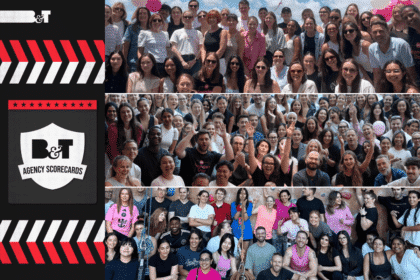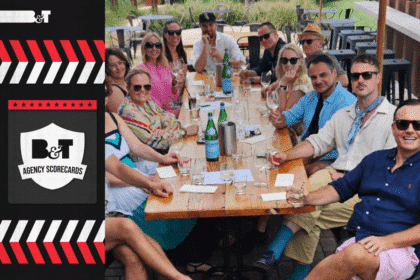It’s a wrap for B&T’s man in the ground at SXSW, as Dan Machen (pictured below) files his final thoughts on the planet’s biggest free-thinking tech fest. Check out Dan’s musings below…
Reflecting on South by Southwest, the world’s biggest tech and innovation conference, is best done in three ways:
- First, by day five you need the embrace of Bruce Sterling’s closing remarks. Sterling is a famous Austin author and de facto ‘sage of South by’ – his closing remarks give you a feel for the festival
- Second, in the start-up village amidst all the shiny stuff from round the world. (Pro Tip: Japan does weird well)
- Third, take a few days to decompress. Actually think about the shit you’ve seen and identify the bigger concepts along with their more near-term relevance
Building on the above, let’s start with Bruce Sterling. Sterling, like many speakers before him, was crystal clear, “everyone knows big technology is terrible for people”. On everyone’s minds is what we must do to recalibrate tech and the Web 3.0. This is no longer about intent, it’s about action – from politicians, to brand behaviours, to citizens voting with their feet to clean up how tech meets the world. This was amplified by Sir Tim Berners-Lee, creator of the Web, which actually celebrated its 30th birthday during SXSW. Speaking to WIRED, Berners-Lee said, “If we give up on building a better web now, then the web will not have failed us. We will have failed the web.”
This put an interesting frame on some of the shiny stuff you see at SXSW, which, while exhilarating, you see through a different lens. The electric scooters from Jump by Uber, Lime and Bird were a great example for me, of tech executed badly. As per my day three article Post Digital Darwin Awards – Scoot Over Now these scooters do represent a short form transport solution for cities in future. With that though goes rider safety training, helmets and transport infrastructure planning. As I said before, this would end up in someone getting hurt and have to be rethought. Sadly, it was reported numerous people were injured, or cautioned by police for reckless riding. There was also one fatality. This is a metaphor for our application of tech – chuck it into the world, see who gets hurt, then relaunch it at twice the price and half the appeal. A physical manifestation of Zuckerberg’s ill-considered, “Move fast and break things”, mantra.
On a less serious note, the start-up village was the weird and wonderful end of the tech sphere this year. Japan – specifically Dentsu – were on top form with a digital BYOB (Bring Your Own Boob) for Dads wanting to get closer to the maternal feeding experience with a strap on breast-shaped feeder.
In addition, Dentsu showcased a ‘Sushi Singularity’ restaurant – coming to Tokyo in 2020. The restaurant tests diners’ DNA and then prints Sushi to optimally meet their nutritional needs – using AI powered algorithms to combine new ingredients. Dentsu’s tagline ‘Pointless brings progress’, while fun, feels like fiddling on the deck of the Titanic – ignoring the very serious challenges raised below decks by tech application.
Having taken a few days back to decompress and consider SXSW this year, people were very aware of a weird world we are in – digital dystopia. But there is light on the horizon for a wonderful world if we use tech for humanity.
This sentiment was reinforced by Douglas Rushkoff, author and World-famous cyber commentator. He commented that we must focus on ‘Team Human’ in the application of tech – it’s about tech for the betterment of humanity, not just humane technology. “When I hear the term humane technology, I think about the writing on a package of cage free chicken… It was raised humanely all the way to the slaughter.” Mark Ritson – closer to our sphere – also thinks digital requires strategic oversight. In his recent article ‘It’s time to shut down digital marketing teams for good’, “Consolidation of teams to remove duplication by specialist digital marketers can’t come soon enough, and will allow us to focus on the consumer.” Both these guys were on the money re sentiment in Austin in terms of a human-centric oversight and convergence.
I’d frame SXSW 2019 as an ABCs, as follows:
A is for Artificiality
Authenticity versus disinformation and FAKE NEWS was a hot topic this year. In his talk,
A Global Tour of Disinformation On Social Media, the founder of Graphica, John Kelly, gave an alarming wake-up call on the level of fake accounts in social and the manipulation of narratives. Tellingly, Kelly said “this is about much more than winning elections”. Russian troll farm teams from St. Petersburg use culture as their gateway to American society and conversation control. While we used to have geo-spatial separation of narratives and politics by country, in our ‘cyber social’ reality today, those lines are increasingly blurred and often deliberately.
Kelly showed that the campaign reacting to Colin Kaepernik for NIKE, ‘#BoycottNike’, was seriously amplified by fake, Russian-owned social media accounts. Hooking people with the NIKE conversation first, these accounts subsequently switched to their own political agenda. The relevance here for brands is to understand the narrative levers of entering conversations in culture / social media and choose to be a ‘good actor’ in a space where so few are.
This sentiment was amplified in the talk Brand: The New Political Reality, which featured a panel with Patagonia, AirBnB and Lyft. They talked about how values and purpose, contribute to narratives that inform wider culture. Respectively this encompassed their sustainability, city infrastructure and housing CSR agendas.
There was an undercurrent in the room as some people grumbled that AirBnB and Lyft, (as brands), were talking a good game, while allegedly driving up rent prices and using self-driving car algorithms to take drivers of their equation. Patagonia was most eloquent on this panel, because their sustainability agenda is reflective of sustainability agenda of the founders of the apparel brand. Patagonia’s Corley Kenna made the key point when she said: “in a world where there is increasing polarisation – driven by AI fuelled programmatic and bad actors – brands need to be increasingly sure about their values and what they stand for.” Like ports in a storm.
B is for Belonging
Dr. Brene´ Brown, one of the leading TED speakers globally, spoke passionately in her session ‘The Only Unfollow That Broke My Heart’. Brown said the unfollow that broke her heart is when she stopped posting due to negative social comments. She said this is the one thing we must never do. We need to lean into the difficult conversations and be true to our authentic selves even if that’s hard.
The key concept was around ‘belonging’. Dr Brown said ‘fitting in’ was you want to be somewhere, belonging is when others want you to be somewhere. How resonant for brands ‘fitting in’ on social media platforms.
This echoed Rohit Bhargava’s keynote, Seven Non-Obvious trends actually changing the future in 2019.
Rohit talked about a ‘believability crisis’ where he is seeing the same brand story told so many different ways that there was a complete erosion of trust.
According to Bhargava the opportunity is ‘the haystack method’. If we understand the ‘hay’ in terms of the potential information landscape, then brands and their audiences can consciously stick the needle in the middle. Again, this builds on the need for more conscious oversight and also to make better choices about where we are spending online – not as easy as it sounds.
C is for Convergence
So as SXSW2019 points towards the need to apply tech in the interests of humanity, how do we begin to do that? Nick Law, CCO of Publicis Groupe gave this a shot in his keynote Creativity in the Age of Invention.
While many talk about the need for empathy in service design and the need to “humanise tech”, Nick Law highlighted the problem we face and then went on to suggest some of the answers.
Law went on to say creativity organises around technology. In the mad men era it was dissected into serialised chunks around TV. Then the web came and then “the web ate storytelling”. Nick added that when he was in RGA, they were like “f*ck advertising” – focused instead making something that would have future value for clients.
Law encouraged brands and agency folk to stop being ‘digital jihadists. Law said we must fundamentally reimagine organisations and creative teams away from the traditional atomic structure of CD, writers and art directors. We need to use proper strategic thinking to reorganise agencies – making them modular. We need to think about how we reunite storytelling with experience builders – as stories are the doorways to human behaviour. We must have the storytellers meet the experience teams to achieve true creative potential and value.
This vision also has a lot of potential for client organisations responding to the challenge of Ritson’s piece that they must unite marketing and digital teams. Why have a digital silo, when most marketing is digital? This has implications for brand oversight and effectiveness – prioritising longer-term brand value in activation, rather than blanket bombing audiences with low cost per click banners.
On the subject of the need to create signal amidst the noise, HeyHuman’s, talk Advertising Detox: How to Reduce Cognitive Load built the sense that we can be more ‘Mindkind’ to mankind. HeyHuman’s Neuroscience Consultant, Aoife McGuinness, showed via a live EEG feed that “engagement is not the only thing.” Brand custodians in the post digital world need to try and be ‘Mindkind,’ by considering that people’s minds are already overloaded. The new opportunity is to make ads easy to process mentally by being recognised, resonant and relevant. Novelty makes brands easier to recall, especially when alloyed with dialled up contextual value.
The final element it would be remiss not to mention is AI. AI and machine learning underpin so much of the ‘weaponisation’ of tech. In some ways AI is the new space race and one that China is currently leading. They are aiming to invest $150 billion by 2030, versus $10 per annum in the US and $1.5 billion in Europe. China also counts for 50% of new AI patents versus 35% for America and 15% for Europe.
There were many creative uses of AI in Austin worthy of note. Rothco’s was one of the most talked about. Rothco built on their, JFK Unsilenced campaign, which used AI to recreate the speech JFK would have given in Dallas had he not been assassinated. In JFK 2020: Could JFK be the next American President, Rothco brought JFK to a new audience to see if they would vote for him over Trump. 64% said they would vote for a virtual President versus a real idiot. This was a great way to illustrate Rothco’s point of debate – just because AI could create political leadership, does that mean it should be allowed. How do we establish the rules for AI and how it influences decision making? Contrast this with how China and others are using AI enabled algorithms and behavioural science to drive decision making, and it’s clear that AI is something we need to establish real rules for.
A centaur approach has always been favoured by most attendees – use AI to do the horse work, but retain human agency in the final choices. This is idealistic I accept, and unfortunately principles are often the first casualty of the commercial war.
To wrap up. While, as usual, SXSW was like trying to take a sip from the fire hydrant of the future, there was a clear sense this year of a move towards a course correction. Big tech is not on our side, and from politicians to people voting with their feet and leaving social channels, there is a movement towards something better. Web 3.0. As Berners-Lee, Rushkoff and Ritson say, it’s time for better oversight and more holistic, longer term approach
While tech used to be an object in our lives, it now feels like we are an object adrift in a sea of tech weaponised narratives. As data-driven futurist Amy Web said, we don’t just get the future we want, we have to fight for it, be present in the choices we make. Only then will we move away from the terrible and weird world we have created, towards the wonderful possibility that tech dangles, but so far, has delivered with mixed results.












